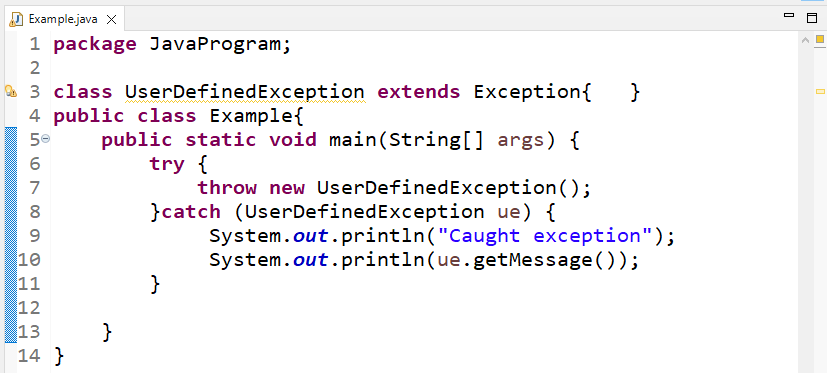This manual will teach the method of creating Java user-defined exceptions.
How to Create a User-Defined Exception in Java?
In Java, you can create an exception and throw it utilizing the “throw” keyword. User-defined or custom exceptions are the names given to these exceptions.
To create a user-defined exception, first, you will extend the class with the “Exception” class and then use one of the below-mentioned methods:
Let’s understand both methods for creating user-defined exceptions with examples.
Method 1: Create a User-Defined Exception in Java Using getMessage() Method
In this section, we will use a “getMessage()” method to throw an exception with the “throw” keyword. We will pass a String that is used as an exception to the constructor of the parent “Exception” class by invoking the “super()” method in the present class constructor.
Syntax
Follow the given syntax for user-defined exception:
Example 1
First, we will extend our class to the “Exception” class, then create a parameterized constructor that takes a String which will be thrown as an exception. In the constructor of the “Example” class, we will pass the String type parameter “s” and call the “super()” method with argument “s” that is passed to a constructor of the parent class:
In the main() method, first we will create an object of the class and pass a string as an argument because the class contains a parameterized constructor. Then, throw an exception with the object of the class. These operations will be added in a try-catch block. Next, in the catch block, we will call the getMessage() method to print the message passed to the parent Exception class using the super() method:
The user-defined exception is thrown:
It is not mandatory that you pass a String to a parent class using the super() method, you can also create a user-defined exception by calling a parent’s constructor without passing any parameter.
Example 2
In this example, we will create a user-defined exception without printing any message. Here, first, we will create a “UserDefinedException” class that extends to the “Exception” class:
In the main() method of the “Example” class, we will throw an exception by creating a new object of the user-defined exception class. In the catch block, we will call the getMessage() method to print the message; however, it will print none because we will not pass any message to it:
Output
Let’s see how we can print exception details rather than specifying it in the parent class constructor.
Method 2: Create a User-Defined Exception Using toString() Method
If you want to print some details related to the exception, use the “toString()” method.
Syntax
Use the given syntax for printing message in user-defined exception:
Example
Here, we will create a toString() method in the user-defined exception class called “UserDefinedException“ by extending it with an “Exception” class. The method will return the string that will be printed out:
public String toString(){
return ("The Exception is occured") ;
}
}
In the main() method, we will call throw the exception using the “throw” keyword by creating a new object of the user-defined class in a try block:
Output
We have compiled all the ways to create a user-defined exception in Java.
Conclusion
For creating a user-defined exception in Java, you will first extend the class to the Exception class, then use two methods, getMessage() and toString() methods. These methods are used to print the messages as an exception. The getMessage() method prints the message passed to the parent class constructor, while the toString() method returns the string that will be used as an exception message. In this manual, we explained the methods for creating a Java user-defined exception with examples.






